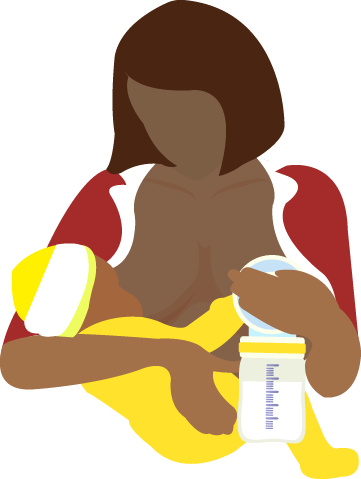For the first six months of life, exclusive breastfeeding is recommended by the AAP, with the addition of nutritious foods added at six months of age. Breastfeeding should continue between months six to 12 or as long as mother and baby mutually desire. Solid foods are not meant to replace breastfeeding, but should be in addition. Breast milk should still be baby’s primary source of nutrition until the baby is 12 months old.
Feeding patterns. Don’t be alarmed if breastfeeding sessions become shorter. Baby will continue to eat every two to four hours throughout the day but go for a longer stretch at night before eating again. If babies are taking bottles, they might eat between 4 to 6 ounces per feeding.
Sleeping patterns. Many babies begin to sleep through the night at this stage. This usually means sleeping one five- to six-hour stretch, possibly longer.
Introducing solids. Solids should complement breast milk at this stage, not replace it. The AAP recommends introducing solids at six months of age, and that first foods are single-ingredient foods such as infant cereals (rice, barley or oats) or pureed meats. These foods provide iron and zinc, which are key nutrients infants require at this stage. To maintain milk supply, mom should try nursing baby before the solid food is given, rather than after, to ensure baby gets the amount of breast milk needed. Breast milk can be used as needed to thin foods to make it easier for baby to swallow. Some parents might think about skipping infant cereals. For a breastfed infant, fruits and vegetables won’t provide iron and zinc, two key nutrients that require a source in the diet at four to six months of age. Infant formulas are fortified, but infants who are exclusively breastfed need iron and zinc at this point.
Signs baby is ready for solids. Parents should consult baby’s pediatrician on when he or she should start eating solids. Generally, baby is ready to start solids when he or she can sit with support, has good head and neck control, pushes up with straight elbows when lying face down and leans forward with an open mouth when interested in food.
Feeding timeline for solids. When baby is four to six months old, offer him or her solids one to two times a day, increasing to three times a day by seven to eight months. Parents should introduce single-ingredient foods every few days to make sure baby shows no signs of allergic reaction. The actual amount of solids a baby will eat may vary greatly based on weight and size of the infant as well as intake of the liquid source of nutrition, either breast milk or formula.
Ways to Increase Milk Supply
Milk removal is the best way to increase milk supply. The more often you breastfeed or pump the more it will signal your body to make. Mothers also need to remember to take care of themselves and get adequate rest, hydration and nutrition so they are healthy and strong enough to make milk for their babies.
Source: JohnS Hopkins Medicine
Link: https://www.hopkinsallchildrens.org/Patients-Families/Parenting/Breastfeeding




